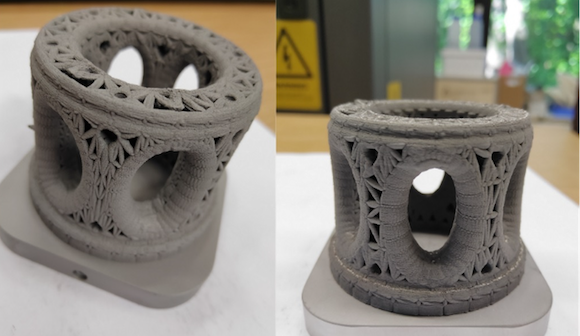Bayerische Metallwerke patents AM process for complex tungsten alloy components
July 30, 2021

Bayerische Metallwerke GmbH, Dachau, Germany, a subsidiary of Gesellschaft für Wolfram Industrie mbH, has developed and patented a new manufacturing process for the tungsten alloys WNiFe and WNiCu in order to increase the efficiency and longevity of highly geometric components. This process is characterised by the use of multi-phase mixed crystal alloy powder, producible from scrap, which is suitable as a starting material for Additive Manufacturing and coating processes.
WNiFe and WNiCu are used in chill-mould casting of aluminium because of their corrosion resistance against molten metal and high thermal conductivity for the chill-mould casting of aluminium; and in tool manufacture and for shielding from alpha and gamma radiation, the heavy metals, with a density comparable to gold, are indispensable. Tungsten, however, has the highest melting point (approximately 3,400°C) of all chemical elements and a Mohs hardness of 7.5, making it very difficult to work with. As a result, components with more complex shapes, such as curves or conical bores, often have to be switched to more easily formable hot-work tool steel.
In the case of the casting moulds, also known as chill moulds, used in aluminium processing, the aim is often to have long, thin and sometimes conical cooling channels of less than 1 mm in diameter in order to ensure the most uniform and rapid heat dissipation possible. Otherwise, the material quality of the end product can be adversely affected by the formation of cracks.
Such precise and sometimes curved shapes are impossible to model from tungsten metal using conventional machining or forming processing techniques owing to the aforementioned high melting point. Therefore, for these sorts of complex components, it has, so far, been necessary to switch to hot-work steel, which can be additively manufactured into almost any shape.
After completing the two-year development phase, Bayerische Metallwerke applied for a patent for its new manufacturing process for a tungsten alloy product and its further use at the beginning of 2020; this was granted in January 2021.
In the absence of an alternative, only a mixed powder has, so far, been used to make tungsten usable for components with complex geometries. The main disadvantage of such mixtures, however, results from the different boiling points of tungsten and nickel (2,700ºC) and iron (3,000ºC) – meaning a large part of the two added substances evaporates in an uncontrolled manner during the melting process.
Utilising the pre-alloying in the process, however, all three elements are combined as a multiphase material in each individual powder particle, so that their composition and distribution in the end product can be precisely controlled and no loss of the binder metals has to be accepted.
According to the common standardised variants, the new alloy can be produced with 80% to 98.5% (weight) tungsten, 0.1% to 15% (weight) nickel, and 0.1% to 10% (weight) iron and/or copper. This achieves a density of the end product of 17 g to 18.8 g/cm3, which is desirable for applications in the aluminium industry, tool manufacture and for alpha and gamma radiation shielding.
“The higher the proportion of tungsten in the end product, the more resistant it is to molten aluminium and the better its thermal conductivity,” stated Hany Gobran, R&D Manager at Bayerische Metallwerke and inventor of the manufacturing technology. “If, on the other hand, good ductility and mechanical machinability play a greater role, the proportion of tungsten in the alloy can also be reduced accordingly. The composition can, therefore, always be adapted to the specific application and the respective complexity of the shape.”
During the comminution process, as part of manufacturing, the flow behaviour and the grain size of the powder between 10 µm and 200 µm can also be determined. In this way, the alloy can be individually prepared for further types of processing, such as plasma coating or Additive Manufacturing.
















